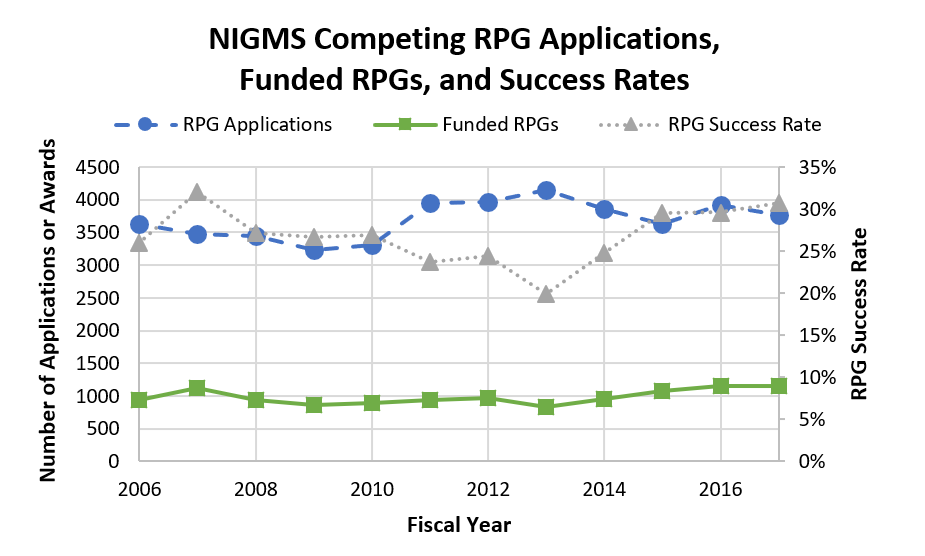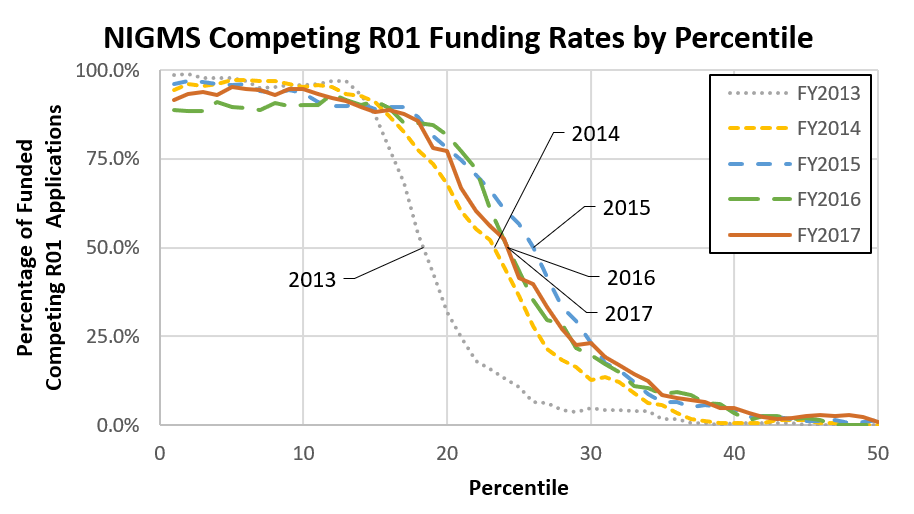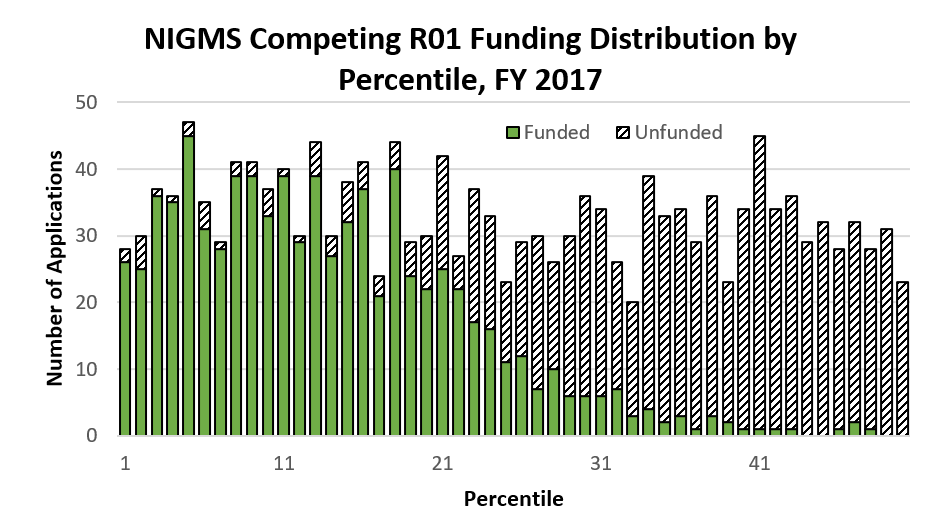NIGMS is committed to ensuring that taxpayers get the best possible returns on their investments in fundamental biomedical research. As part of this commitment to stewardship, we regularly monitor trends in our funding portfolio.
We recognize the value of a diversified investment portfolio and approach our research investments in a similar fashion. Sustaining a broad and diverse portfolio of talented investigators is a central goal of the Institute, as a wide variety of research questions can be studied by an investigator pool that comprises many different backgrounds, fields, and skills. To monitor this, we track the “cumulative investigator rate,” which indicates the proportion of unique investigators actively seeking funding who had an NIGMS grant in a given Fiscal Year (FY). As shown in Figure 1, the number of investigators seeking support consistently increased between FY 2006 and 2014, but the number of NIGMS-funded investigators remained relatively unchanged over that same period. As a result, the cumulative investigator rate steadily decreased. Since FY 2014, the cumulative investigator rate has steadily increased, as the number of applicants seeking support has stabilized and the number of investigators receiving support has grown by 14%. Currently, 37.4% of investigators seeking R01/R35 funding from NIGMS received support in FY 2017.
As part of our commitment to a diverse portfolio, we also emphasize support for the next generation of biomedical researchers. Supporting early stage investigators (ESIs), as well as maintaining stable support for investigators through their critical first renewals, is essential to maintaining a vibrant research community. As shown in Figure 2, the number of ESIs receiving their first competing NIGMS major research project grant has increased in the last two years. This is due, in part, to interest in our Maximizing Investigators’ Research Award (MIRA) R35 grant program which includes a funding opportunity for early stage investigators. As we move forward, we will continue to track the stability of support for investigators across all stages of their research careers.
In addition, we track more traditional measures of our grants portfolio, such as the success rate, calculated as the number of applications funded divided by the number of unique project proposals received. As shown in Figure 3, the NIGMS research project grants (RPGs) success rate for FY 2017 was 30.7%, a percentage point higher than the success rate in FY 2016. We received slightly fewer competing applications in FY 2017 than 2016, and made nearly the same number of awards, resulting in a similar success rate. This marks the third year in a row that success rates have remained relatively stable since their lowest point in FY 2013. MIRA applications and grants are included in these counts for RPGs.
As noted above, changes in the numbers of both competing applications and awards influence our success rate. The number of competing applications submitted is largely driven by the research community, although the increasing percentage of investigators with funding since FY 2014 (Figure 1) could have led to a decrease in the number of people submitting applications. In addition, researchers funded through the MIRA program do not submit additional research grant applications to NIGMS, which will lead over time to a decrease in applications. The number of competing grants awarded is affected by our funding policies, budget, and existing commitments to active grants. As stated in our 2015 Strategic Plan, we have been making efforts to bolster support for investigator-initiated research and for individual researchers through careful consideration of our portfolio and funding policies.
As mentioned in our previous funding trends posts, we do not use a strict percentile cutoff (“payline”) to make funding decisions. Instead, we take a variety of factors into account, including peer review scores, summary statements, the relevance of the research area to the Institute’s mission, overall portfolio diversity, and an applicant’s other research support. As a result, a significant number of applications each year are in the “fundable” range, as shown in the funding plots in Figures 4 and 5. In FY 2017, approximately 50% of applications that scored at the 24th percentile were funded, identical to the value in FY 2016 (Figure 4). As with last year, a number of well-scoring R01 applications went unfunded, in part due to NIGMS policies on support for research in well-funded laboratories and funding for investigators with substantial unrestricted support. In general, a well-scoring application for an investigator’s third R01 will be a lower priority for funding than a meritorious application for another investigator’s only grant.
Similar figures are not shown for the MIRA program, as applications are not percentiled and the program is still in its early phases. NIGMS has been carefully monitoring the MIRA program and communicating its findings via regular Feedback Loop posts and will continue to do so.
In FY 2018, NIGMS has been operating under a continuing resolution, meaning that our budget is at a similar level to FY 2017. During this time, we are following current guidance as it relates to issuance of awards. However, we continue to use every analytical tool at our disposal to ensure that we maximize scientific returns on taxpayers’ investments by supporting a vibrant and diverse portfolio of outstanding fundamental biomedical research.







Publish the data by US regional map and by gender and ethnicity.
Thank you for your interest in additional dimensions of analysis for the NIGMS portfolio.
NIH RePORTER is a publicly-facing tool that allows users to identify and visualize grants along a number of different dimensions, including NIH investments by state. See NIGMS’ RPG support by states in FY 2017. This tool has the added benefit of allowing users to “drill down” and identify the grants that were awarded.
NIGMS has a strong interest in the diversity of the biomedical workforce, and has been monitoring for any trends in success rates along demographic variables as we implement the MIRA program. We plan to update this post with similar historical analyses for the NIGMS RPG applicant pool once the data have been properly collected, analyzed, and validated.
As always, thanks a lot for the metrics and the transparency in funding decisions and outcomes at NIGMS. I have one request that I think many of us might appreciate. You state that success rate is “calculated as the number of applications funded divided by the number of unique project proposals received”. I think an equally useful/important metric is the percentage of submissions that are funded. I believe your metric would count a funded A1 application as 100% success, even though it took two submissions and thus for the writer is a 50% success rate. As a writer of grants and often needing to decide where to best target an application between different, appropriate institutes, I think both metrics are valuable and could easily be included in your datasets and thus I would appreciate seeing both numbers.
While they do not provide an overall “funding rate” number, figures 4 and 5 in the post include A0 and A1 submissions as separate entries. These figures provide a more detailed look at the likelihood that a grant submission is funded given its review outcome. Bear in mind, referral of an application to an Institute or Center is subject to the NIH’s Receipt and Referral process, and we recommend that you reach out to a relevant program officer if you have questions about whether your proposal fits within the research priorities of NIGMS.